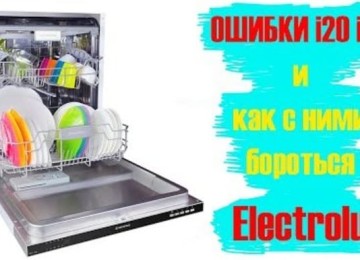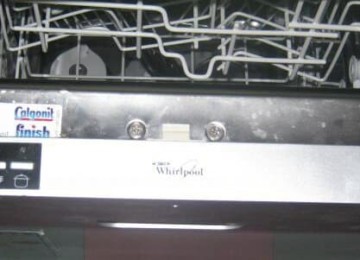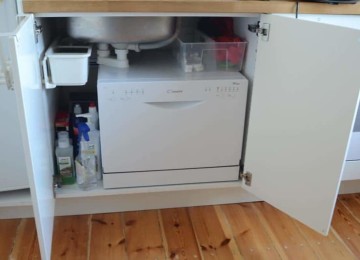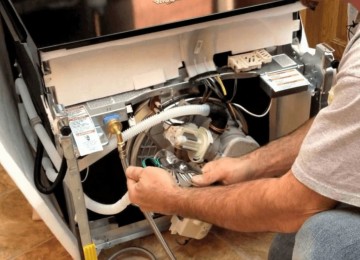During the period of the global technological revolution and mass automation of human life, comfortable living and ease of housework are not the least important. One of the fundamental kitchen appliances is dishwashers. Despite the fact that their popularity is noticeably lower than that of other equipment, they remain in demand and necessary for people, as they greatly simplify the process of washing dishes. But using them is one thing; knowing how to choose a built-in dishwasher is another matter.
Features of built-in dishwashers
Such models are given the greatest preference among consumers, since they not only do their job well due to direct access to the house’s water system, but also do not take up a separate place in the house, allowing them to save space.
The most popular types of built-in dishwashers are narrow. They are installed on an area of 45 cm and below, since the exact size for the equipment depends on the size and location inside the kitchen. Narrow models are purchased for cramped kitchens, where every square centimeter counts.
Despite their small dimensions, narrow dishwashers can accommodate up to 12 sets of kitchen utensils. Before purchasing, it is worth considering that by default the maximum capacity is always 1 unit more than it can accommodate. This is done to level out the difference in the number of utensils included.
A built-in dishwasher up to 45 cm wide allows you to leave the original layout of the kitchen without increasing or decreasing the area for placing equipment. However, when choosing, you need to clarify the following points:
- Geometric information: they must be calculated with mathematical accuracy, taking into account the dimensions of the kitchen. Scratching equipment is unacceptable, as this leads to premature damage to the equipment.
- Contact of the headset with the dishwasher: as in the first case, this leads to scratches and damage to the dishwasher.
- Studying the instructions: it is necessary to know exactly the procedure for installing the equipment, since otherwise it will not work.
- Drainage system: you need to carefully consider the scheme for its creation.A hole is created in the cabinet to transport water and washing liquid to the dishwasher, after which the equipment is connected to a 220 V power cable.
- Doors: opening or closing them should not interfere with the loading of kitchen utensils. Otherwise, the operation of the equipment may be incorrect and disrupted.
It is the narrowness of built-in dishwashers that ensures their high popularity and demand in everyday life, as it allows not only to save on size, but also not to disturb the kitchen space. Unlike large models, small ones fully take into account the area of the territory and markings for installing equipment.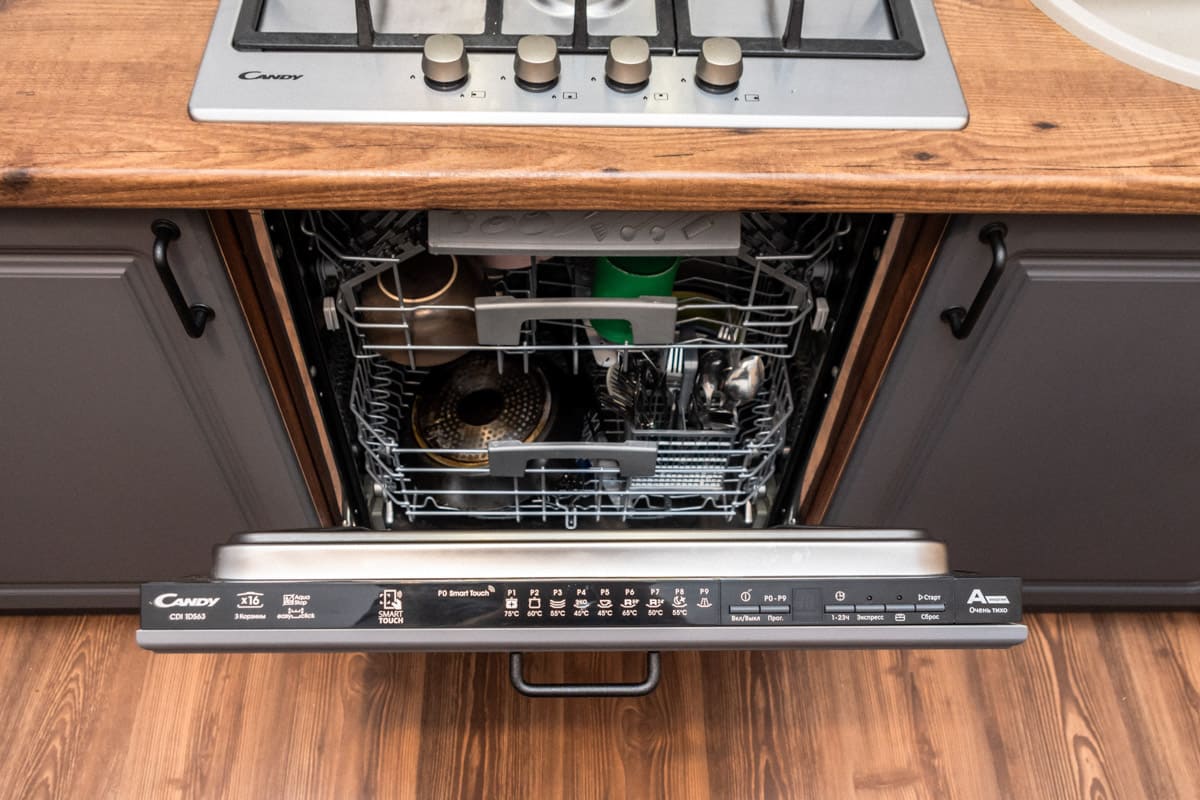
What types of built-in dishwashers are there?
There are partially and fully built-in models. Both types cannot be installed separately from the kitchen equipment due to the lack of a decorative dashboard. They are often presented in narrow dimensions - this pattern is due to the need for high-quality internal installation and subsequent trouble-free operation.
The structure is covered with a table top on top to avoid external damage to the equipment during a water supply failure or its interruption while the equipment is operating. The internal component presents the same picture as in other species. The functionality of the models is completely the same, with the exception of the location of the control panel and its additional functions.
Fully built-in
The headset is installed directly into the niche, covered with a metal table top. The door is equipped with a hinged facade, the material of which is selected based on the kitchen.Thus, thanks to such a selection, you can achieve the perfect balance of the dishwasher with the rest of the kitchen, without losing ease of use and functionality.
Fully built-in models not only allow you to preserve the natural look of the kitchen, but are also completely safe for children, since they will not be able to just open it or climb inside. Some types are also able to work silently, but this is a rare case.
The main disadvantage of built-in dishwashers is their inconvenient location and limited space. For them, you need to calculate a certain area, be sure to place it in a prepared space, risking worsening the condition of the furniture. An additional problem is the lack of decorative side panels, which do not allow you to choose a specific place for installation, only in a pre-prepared one.
The main problem with built-in appliances is the door. To install it, a hinged facade is required, otherwise it simply will not close or fix in the desired position. If there is no possibility of installing a facade, then you should abandon the fully built-in dishwasher. Partially built-in
The main difference from fully built-in types is the location of the control panel. Here it is located on the top of the door, often attached to the facade. A decorative panel is attached to the lower part of the structure, allowing you to monitor the dishwashing process from afar and control it if necessary.
The huge advantage of partially built-in types of dishwashers over fully installed models is the visual part of the design.In addition to greater functionality that reduces manual work and allows you to track the process of washing kitchen utensils, the appearance of the equipment looks much better than its analogues.
The disadvantage of partially built-in models is their inflated price, which is due to their high manufacturability and practicality. However, the high costs are offset by the ability to leave the door in any position while washing dishes.
Criteria for choosing dishwashers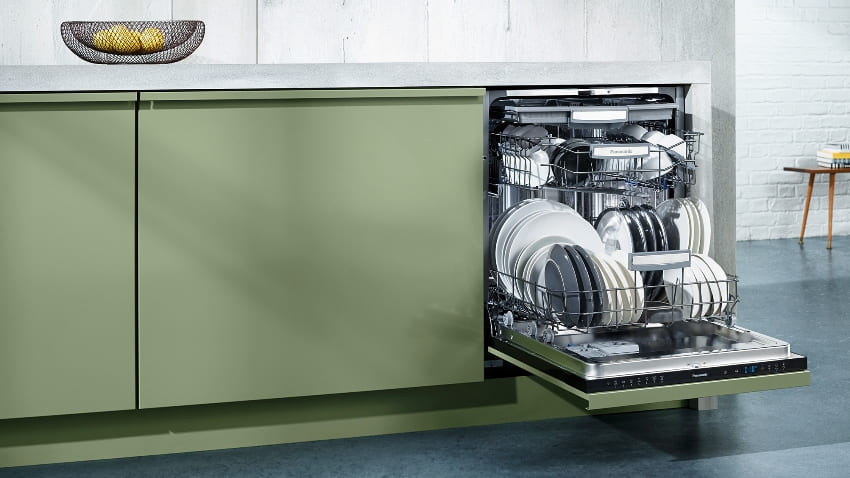
When choosing this equipment, it is necessary to take into account several factors that have a direct impact on the model and functionality of the equipment. Having familiarized yourself with them, you can not only choose the right dishwasher, but also find the right manufacturer, since most companies specialize only in the production of certain types of dishwashing equipment.
It is important to study the pros and cons of the products that are preferred. Despite the possible functionality and high-quality automated work, it may not be suitable for the kitchen or may not correspond to the allotted area. Don’t forget about the application parameters: they are important because they allow you to adapt to utensils and dishes without losing power.
Technical parameters are the most important part when selecting a dishwasher. These often represent the dimensions, width and length of the equipment. Not only the capacity and dimensions of the equipment depend on these values, but also its price, since the greatest preference is given to models with a size of 45 cm or more, giving rise to the greatest offer from manufacturers.
The last important point is the possibility of upgrading and improving functionality using third-party equipment or chemical reactions.One such example is the use of cold water supply. It not only extends the life of the dishwasher, but also allows you to better deal with complex stains.
Dimensions
All modifications and types of built-in dishwashers are divided into the following types:
- Narrow: they are small-sized models that can hold up to 11 sets of dishes. The sizes most often used for them are 50x55x90 cm. Designed for average families consisting of 3-4 people. Quite safe for children, as it requires some effort to open the door.
- Standard: the most common type of dishwasher, holding up to 16 sets of kitchen utensils. Common sizes: 55x65x80 cm. This type of equipment is most widely used in large families consisting of 5-8 people. Child safety is also respected, but the dishwasher is a little easier to open so care must be taken.
- Compact: suitable for cramped kitchens, they have the smallest dimensions among all dishwashers, which is why they can accommodate up to 7 sets of dishes. Used for personal use or in childless families. There is virtually no safety for children, so it is necessary to carefully monitor the child when he is present in the kitchen or is unattended.
As it becomes clear, one of the main factors determining the dimensions of a dishwasher is safety for children. If they are in the family, then it is better to lean towards standard and narrow models, as they are well equipped and will not allow them to just climb inside or open the door.
Capacity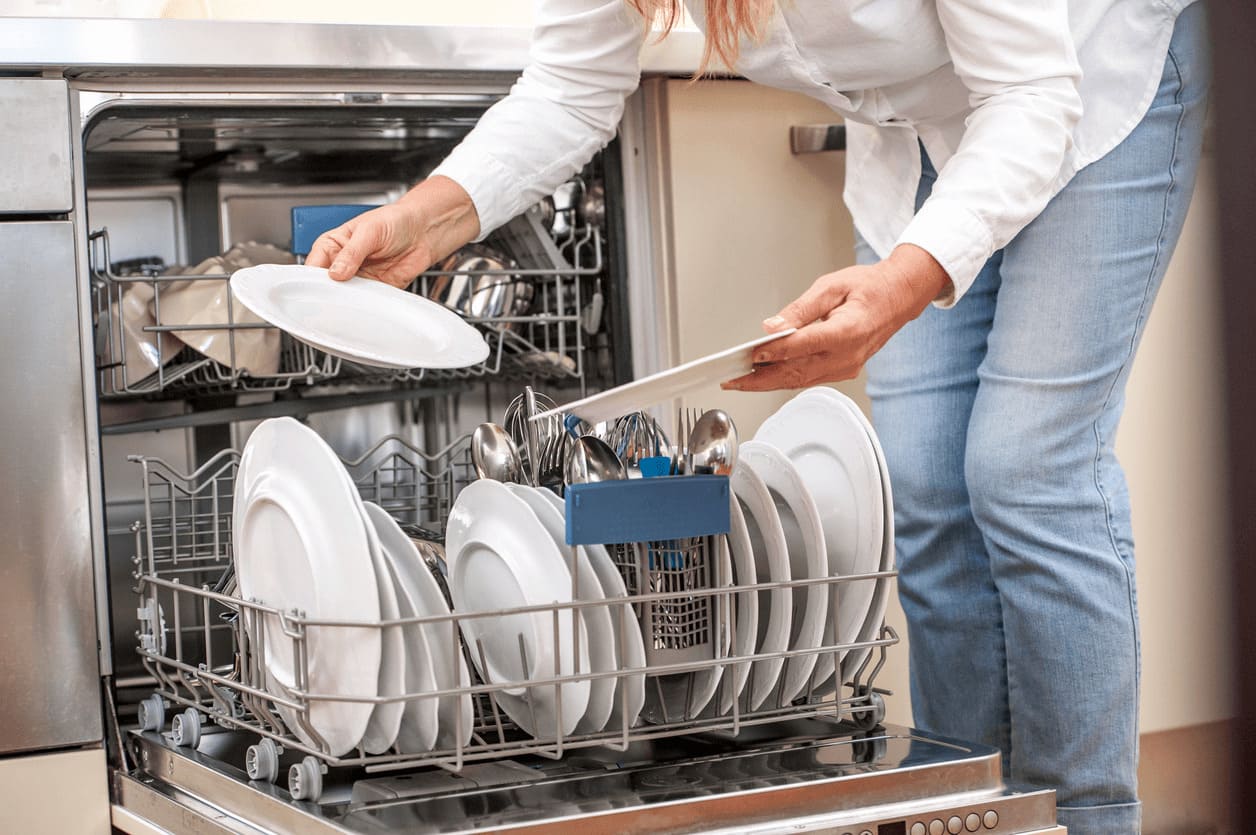
The unit of measurement for the capacity of built-in dishwashers is the number of sets of kitchen utensils that fit inside the equipment. The division into types is exactly the same as in the case of dimensions, but the principle of classification is completely different. The selection of equipment is carried out based on the size of the family.
Standard dishwashers can hold up to 16 place settings. Their functionality is designed to serve a family of 5 or more people. Pots, spoons, forks, plates and small bowls can be used as kitchen utensils.
Narrow models of built-in dishwashers are designed for average families with several children. Capable of handling up to 11 sets of dishes, while ensuring complete safety and harmony with the rest of the kitchen due to their small size and selection for the kitchen and safety for children. It is advisable to place only plates, spoons, forks and small bowls inside the equipment. Pots and other utensils must be processed separately.
Compact dishwashers are suitable for childless families, as they are quite cheap and economical. They can hold up to 6 sets of dishes, but you can place absolutely any utensils inside – from cutlery to pots and deep bowls.
Resource consumption
Another tangible advantage of built-in dishwashers is the regulation of water and electricity consumption. It should be understood that this opportunity must be used wisely, since a shift towards complete savings or blind waste of resources leads to inefficient operation of the equipment.
Unfortunately, it is impossible to completely control the consumption of electricity and water.These parameters are determined by the manufacturer when creating the product, so you need to lean towards a company that can provide built-in dishwashers with the right efficiency. For convenience, a division according to the waste of resources was introduced. There are many of them, but for ordinary consumers only classes A and A+ are of interest.
Both classes are capable of spending the required amount of resources for automated dishwashing. The difference between them is consumption. “A” allows you to use less electricity, but takes more water, “A+” is the opposite. On average, 22 liters of water are required to process 10 sets, which is much less than washing by hand.
There are economical models that can process several sets of kitchen utensils, while spending a minimum amount of resources.
Interesting information: electricity consumption is directly proportional to water consumption - the more water resources are spent, the more electricity is used. The proportion is 1x1.2.
Software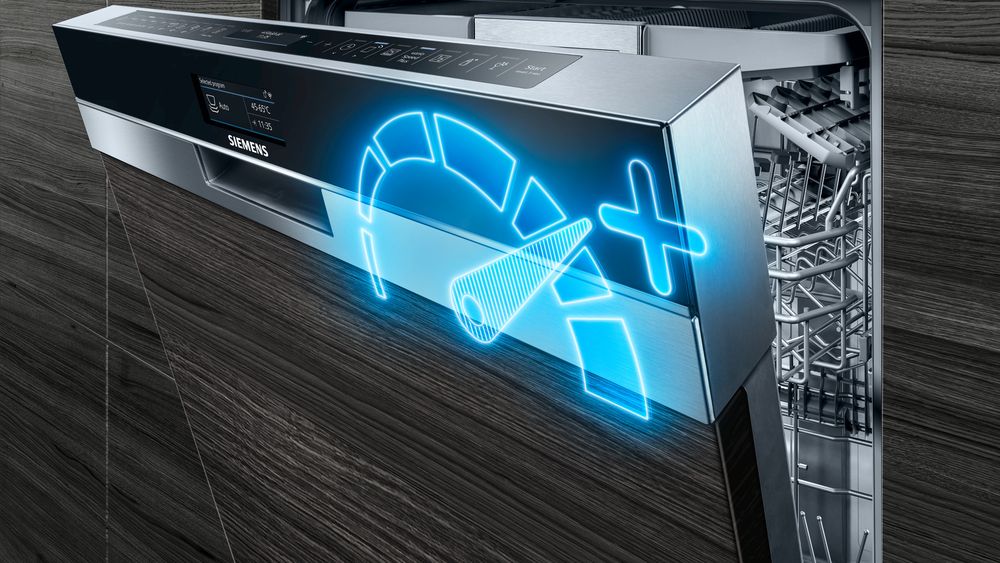
All dishwashers have 4 standard dishwashing programs: standard, accelerated, express cycle, pre-soak. The intensive mode allows you to complete the treatment in 30-50 minutes at temperatures below 70 degrees. It also has an accelerated version, but it is suitable for working with small stains and dirt with an amplitude of up to 40 degrees.
The express cycle is the most economical option, but at the same time the longest, due to the low heating of the water. The process of processing dishes takes up to 3 hours, but the result is more than decent. Using the express cycle on heavy stains is not recommended as it is a waste of time.
Pre-soaking is an additional dishwashing process that can be used as a primary treatment and subsequent fight against heavy dirt. The dishes are rinsed with cold water for 10-20 minutes, after which the mode is switched.
For regular processing of kitchen utensils, you can use the standard rinsing mode. The washing process lasts up to 2 hours at a temperature of up to 60 degrees. The dishes are processed with warm water, without the use of third-party chemicals and cleaning agents. It is not recommended to use against food residues and heavy stains.
Additional washing modes
Most large manufacturers add a number of application functions to built-in dishwashers. Their number directly depends on the price, so if you need smart equipment, you need to lean towards expensive models. Basically, the set of functions looks like this:
- Processing of fragile utensils and tea sets.
- Energy-saving processing mode against small stains. Adding chemicals: This biological program allows you to fight dirt by adding cleaning chemicals under the influence of cold water.
- The most useful application function is the semi-load. It allows you to place small batches of sets in the dishwasher, which not only saves resources, but also allows you to use the equipment on a regular basis.
Important: all built-in dishwashers have a choice of temperature mode. It allows you to balance between warm, hot, cold water and boiling water. The maximum temperature amplitude is 80 degrees.
Drying type
Among dishwashers, there is a class division by quality and type of drying.Pre-soaking is an additional dishwashing process that can be used as a primary treatment and subsequent fight against heavy soiling. The dishes are rinsed with cold water for 10-20 minutes, after which the mode switches.
For normal cleaning of kitchen utensils, you can use the standard rinsing mode. The washing process lasts up to 2 hours at temperatures up to 60 degrees. Dishes are treated with warm water, without the use of third-party chemicals and cleaning agents. It is not recommended to use against food residues and heavy stains.
- Additional washing modes
- Most major manufacturers add a number of application functions to built-in dishwashers. Their number directly depends on the price, so if you need smart equipment, you need to lean towards expensive models. Basically the set of functions looks like this:
Handling fragile utensils and services.
Energy-saving treatment mode against small stains.
Chemical Addition: This biological program combats dirt by adding cleaning chemicals under cold water.
The most useful application function is semi-loading. It allows you to place small batches of kits in the dishwasher, which not only saves resources, but also allows you to use the equipment on a regular basis.
- Important: all built-in dishwashers have a choice of temperature settings. It allows you to balance between warm, hot, cold water and boiling water. The maximum temperature amplitude is 80 degrees.
- Drying type
Among dishwashers, there is a class division based on quality and type of drying.There are 2 modes in total:
Condensation: a basic method of drying dishes, used in conventional dishwashers without additional functions. At the end of the process, the utensils are rinsed with warm water, after which the natural process of moisture condensation begins inside the equipment. Advantages - complete silence and economy, disadvantages - accumulation of water and duration.
Accelerated drying: is a structure connecting a fan and a heating element - they fill the chamber with warm air, accelerating the drying process of dishes. There are modified versions with the ability to touch-touch the process - they reduce energy costs and reduce the drying time of kitchen utensils. The plus is a high-quality result, the minuses are high cost and waste of resources.
Also, when drying, you can use a heat exchanger: most of the moisture accumulates in it, which speeds up the drying process, but consumes more electricity.
Liquid leak protection
- This system protects equipment from excessive water overflow, and also turns off the dishwasher if it breaks down. The remaining water is drained into the sewer. This function is applied, but modern dishwashers are not produced without it. It may only be missing in older models; new ones are equipped with it according to state production standards.
- There are 2 types of dishwasher protection against water leaks:
- Absolute: most often used in the most expensive and technologically advanced models. It is a smart system of hoses that are triggered when there is a risk of flooding. If the internal water supply is damaged, the liquid supply automatically stops.
Partial: found in economy class models.When flooding occurs, the water supply stops, but this is done too late. The subsequent start-up of the fluid after repairing the equipment must be done manually.
In order to get rid of water after flooding, it is necessary to properly equip the drainage system. There are several methods, but most often the choice is to connect to the sewer.
Equipment installation
The design of the dishwasher consists of numerous fasteners, hoses and connecting elements. Installing the equipment requires basic installation skills, so there shouldn't be any problems. But you still need to know that incorrect connection leads to equipment breakdown and damage to the dishwasher.
Before connecting, it is necessary to check the cleaning filters for contamination and malfunctions. If there are any, they need to be eliminated, since a faulty water filtration system leads to the accumulation of waste and rusting of the water. To avoid this, filters must be treated with alcohol or citric acid.
The dishwasher must be connected to the following places:
Electricity meter.
Cold water pressure.
Sewerage.
After connection, it is necessary to test the equipment for functionality. If all is well, then you can start using the built-in dishwasher.
Noise adjustment
This parameter is selected individually, since one group of people is not bothered by excessive noise while washing dishes, but the rest are annoyed by it. Because of this, most modern dishwashers have a sound control.
When working at night, it is better to set the range from 30 to 45 dB - in this case, the noise of the equipment is minimized without disturbing sleep patterns or disturbing the owners of the house.
If the budget is insufficient, you can focus on equipment that does not have the ability to regulate noise. In this case, you will have to get used to the excessive volume of the dishwasher.
Equipment management
Dishwashers have 2 user settings and control modes - manual and touch. The first type is almost never found in modern models due to low technology; it can only be found in older versions. It is easy to set up if you have certain skills.
The electronic type of control is also very convenient, but it is not suitable for the older generation due to the complex interface and numerous set of functions, which are quite difficult to understand without basic knowledge.
Review of the best brands producing dishwashing appliances
Due to high demand, most major appliance manufacturers make dishwashers as one of the company's core products. The 3 best manufacturers are discussed below.
Bosch
The German industrial giant offers all types of built-in dishwashers, great functionality and product quality. Bosch products are leaders in the household appliances market. The main reason for such popularity is the ease of assembly and use without compromising manufacturability.
The company's designers offer hundreds of different options for adapting to the kitchen conditions without disturbing the original appearance of the room. The range includes standard models, as well as narrow and compact ones. Thanks to this diversity, Bosch products are suitable for all types of consumers.
Users themselves notice the high functionality of the product, which combines not only smart technologies in the form of hoses, sensors and automatic cleaning and washing systems, but also simple details that almost anyone can understand. Performance is also taken into account without wasting unnecessary energy and water resources.
The only drawback of Bosch products is the high price.
Gorenje
The Slovenian company is significantly inferior to industrial giants, but every year it is gaining popularity in narrow consumer circles due to the growing technology, durability and strength of dishwashers.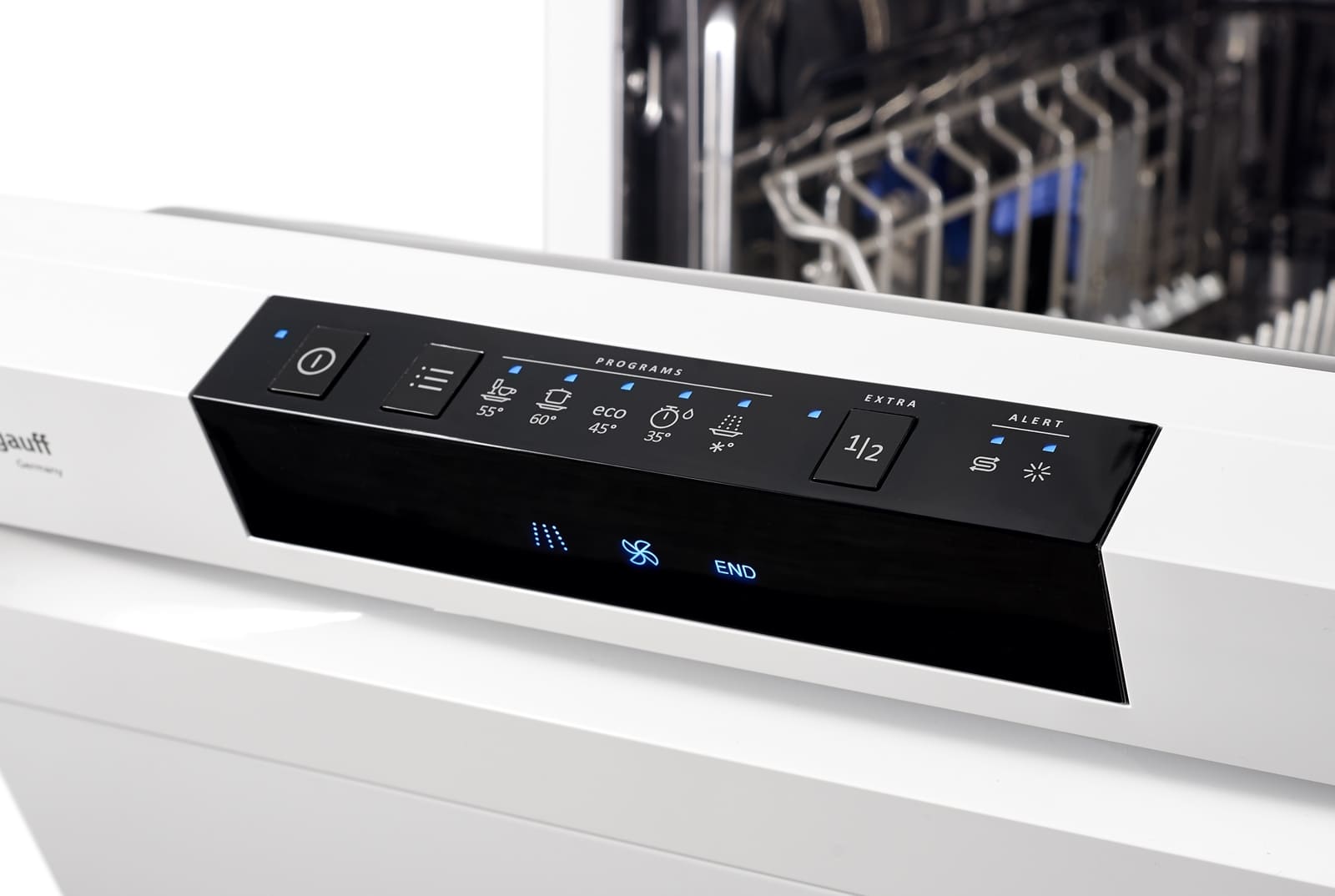
The technology for creating equipment is based on average functionality, capable of performing high-quality dishwashing with minimal consumption of resources. In the entire market of built-in dishwashers, only Gorenje products are capable of using only 8 liters of water per processing cycle, while perfectly cleaning the dishes.
Consumers of the product note high safety and high-quality dishwashing due to the presence of cleanliness sensors and a system of emergency drainage hoses, however, due to low functionality, a considerable part of users abandon the company’s equipment.
Indesit
Factories of the Italian brand are based in China and Poland. They assemble and create new technologies. In production, the company focuses on hygiene and comfortable use without the risk of emergency situations. Much attention is paid to the internal components of the equipment - this is what the company’s products are famous for.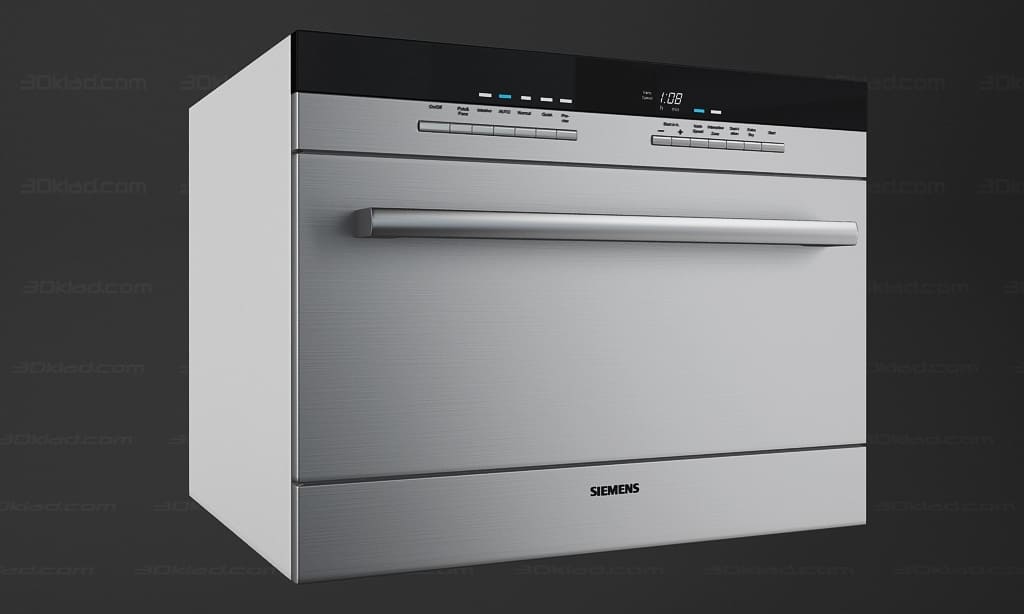
Every year, Indesit products are modernized: powerful engines and motors are added, the hydraulic system is updated. These changes make pollution control more effective.This is noted by consumers who have been using the products of the Italian company for a long time.
Among the shortcomings, users note the lack of modes that clean filters from contaminants, the poor quality of processing kitchen utensils in economic mode, as well as the unavailability of equipment for washing fragile dishes or dinnerware.
Top 6 best models of built-in dishwashers
This selection contains the most technologically advanced built-in dishwashers, the use of which leaves positive emotions. Of course, they are all not without their drawbacks.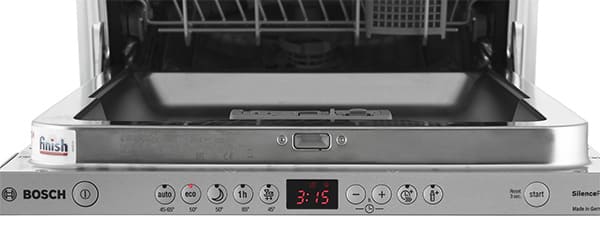
Weissgauff DW 4015
An economical version of a narrow dishwasher with a width of 45 cm allows you to place the equipment in any part of the kitchen: on the countertop, near the refrigerator or under the sink.
Despite its small size, the ratio of which is 40x65x85 cm, it can accommodate up to 10 sets of kitchen utensils. Electricity and water consumption remains low, consuming 0.72 kWh and 11 liters, respectively. When using a semi-load or express cycle, the operating time can be as little as 20-30 minutes. If it is necessary to clean dishes from complex stains, a thorough mode is available. The duration of washing dishes with it is up to 200 minutes.
Consumers note good capacity and internal equipment that allows loading dinnerware and fragile dishes, low power consumption, as well as a good protection system against water leaks. Disadvantages include the inability to be built into kitchen furniture, as well as a one-way notification system.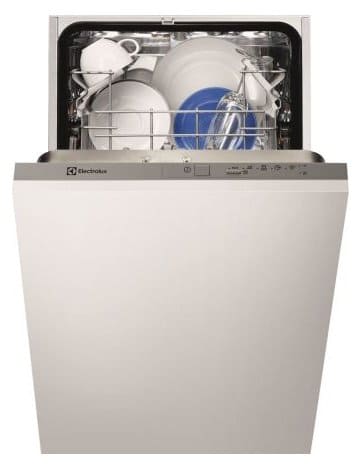
Siemens SK 76M544
The compact dishwasher offers moderate noise reduction and a variety of temperature settings for processing dishes.The equipment includes washing modes for fragile dishes, soaking and economical rinsing.
Places up to 7 sets of kitchen utensils with dimensions of 55x65x45 cm. Consumes an average amount of electricity, compensating for large expenses with low consumption of water resources. One full cycle will require 9 liters of water and 0.91 kW/h of electricity.
Users praise the dishwasher for its quietness and comparative economy, pleasant and convenient design, safety for children and the ability to be directly integrated into kitchen furniture. However, the excessive duration of the process, insufficient functionality and small capacity become the reasons for general dissatisfaction on the part of consumers.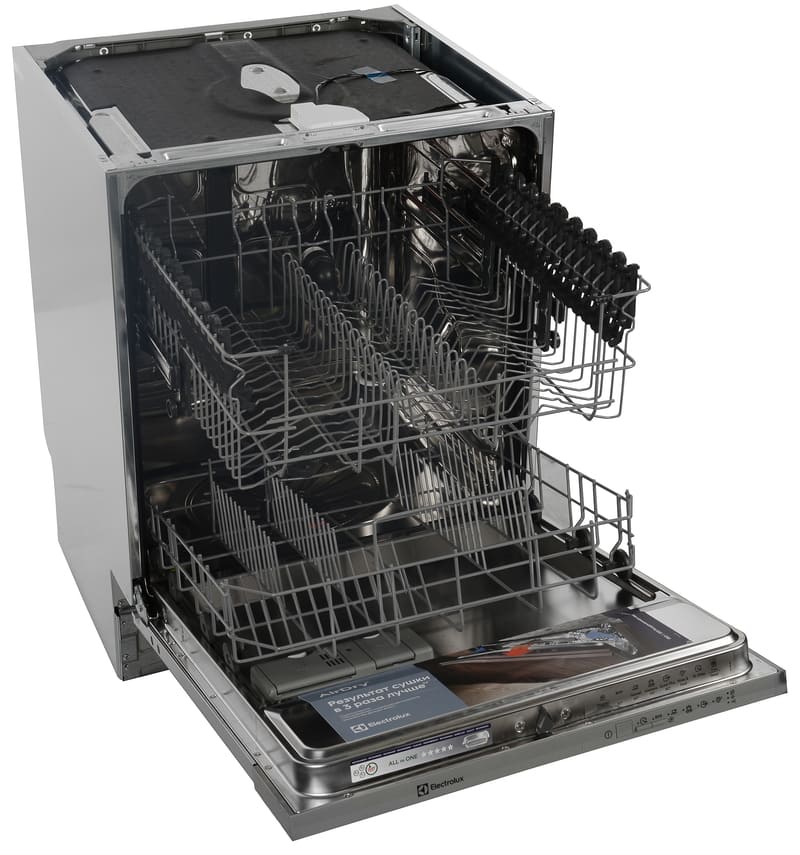
Bosch SPV45DX10R
For cramped kitchens, a narrow built-in washing machine from the German company Bosch is ideal. Low dimensions (40x55x55 cm) take up a minimum amount of space, while being able to serve up to 9 sets of dishes. This is achieved thanks to good internal equipment, in which 3 rocker arms are located.
An ideal automated hose protection system completely eliminates the risk of leaks due to equipment problems. Economy is also high: the dishwasher consumes 0.9 kWh of electricity and 8.7 liters of water per full cycle. Manual and automatic door closing system will prevent children from getting inside the equipment.
Among the advantages, users note noiselessness, low power consumption, high functionality and a good system of internal and external protection. The disadvantages include the lack of a mode for washing fragile dishes and semi-loading.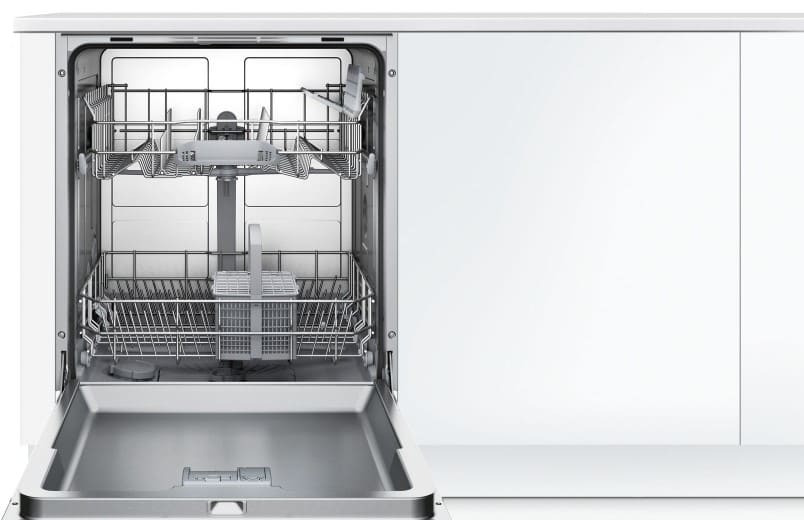
Electrolux 90200
This model is attractive with electronic and automatic controls, as well as a variety of drying modes. Moderate noise combined with 3 temperature settings allows you to cope with almost any contaminant.
The dishwasher can hold up to 9 sets of kitchen utensils with dimensions of 50x50x78 cm. It consumes more water and electricity, but compensates for the costs with high-quality and fast drying.
- Owners note excellent internal protection and a technologically advanced interior surface, which provides adjustability and separate holders for glasses. Disadvantages include low technology and excessive noise.
- Electrolux 917100
- This model is characterized by low energy consumption and a powerful motor, which allows for quick processing of kitchen utensils. The flexible installation system allows you to place the dishwasher in almost any part of the kitchen.
The equipment offers 5 different operating modes with the ability to individually configure temperature and drying modes. To quickly process dishes, you can select the intensive operating mode - in this case, the washing time is reduced to 20-40 minutes.
Among the advantages, users note high technology, moderate consumption of electricity and water, as well as low noise. Disadvantages: insufficient protection against liquid leakage and lack of night operation.
Bosch SMV24AX02R






